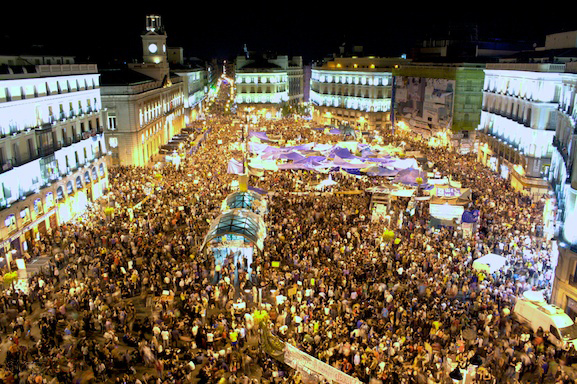Information as an ecosystem, organization as an ecosystem, too: The complex composition of the current wave of mobilizations
In this time of many crises – ecological, political, financial and geopolitical restructuring – large mobilizations are occurring in several places such as the Arab countries, Iceland, Greece and United States. Spain has also witnessed an emerging wave of social mobilization starting on 15M (May 15, 2011) with some of the largest demonstrations, since the country transitioned to democracy in the 70s, comprising large-scale occupations of public squares and attempts to prevent the functioning of parliament by many thousands of people. 15M – alternatively known as indignados mobilization –not only caused surprise because of the size of the protest, but also by its character. With new technologies in information and communication (ICTs) playing an important role in the mobilization process, the 15M movement has become the latest and greatest exponent of “self-mobilization” arranged through the Internet.
The past March 21st, we celebrated here at the Berkman center for Internet & society a very interesting workshop on “Understanding the New Wave of Social Cooperation: A Triangulation of the Arab Revolutions, European Mobilizations and the American Occupy Movement”. One of the workshop line of discussion was movement composition. Pointing to the diverse composition of occupy movement, arab spring, and European mobilizations. Many interesting reflections emerged. Additionally, all this last week I have been working with interviews and other empirical materials in order to further analyze and characterize the 15M composition in Spain for an article I wrote. Here my main conclusion: It is not easy to describe the composition of the overall 15M, complexity is the main characteristic of 15M format.
 The Puerta del Sol square in Madrid May 2011
The Puerta del Sol square in Madrid May 2011
The Global Justice Movement (GJM) of the early 2000s was described as a “movement of movements”. However, this characterization does not suit the 15M, as it has many more layers that together create a complex ecosystem. As it happens with information, happens with organization. In my view, 15M composition is characterized as a complex ecosystem of diverse layers. These layers include a new generation of mobilized citizens, and the juxtaposition of the housing movement and Free culture movement creating the first surprising start; then, in the squares, the convergence of the anti-austerity trajectory of mobilization, student movement, occupied social centers, and the alternative practices resulting from the previous wave of the GJM; the “info-actions” of individual networked at home, that helps the sustainability of an international network of solidarity; then, the support and solidarity against the oppression of previous generations fighting for political freedom in the transition to democracy, and, the strong support of much of the population for the precarious living conditions – altogether generating a virtual cycle that obtained large social support and engagement (online and off-line) for the mobilizations.
15M as a complex ecosystem of diverse layers creates challenges for analytical and methodological designs of social movements, particularly for the approaches that frame participation as an isolated individual activity or that analyzes only one type of participation. For example, it is common in the social movements literature to focus only on strong participants, to focus only on leaders or in strongly committed activist. In my view, these designs are limited and inadequate. Instead, I argue that paying attention to and considering the complexity of participation layers in the research design is appropriate, as each of the layers is important and plays a role to understand the overall process. However, using an ecosystem approach in the analysis of 15M – or other examples of the current wave of mobilization world wise – clearly represents a methodological challenge.